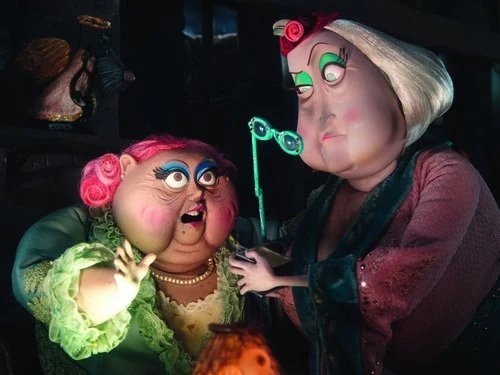Family-Friendly Queer Horror: How Laika Studios Does it All
November 6, 2024
The terms family-friendly, queer, and horror are often not seen in the same sentence, let alone in an entire film franchise. However, Laika Studios has found a way to combine them without being overly obvious in their representation and not falling into stereotypes. There are two case studies in particular that I want to focus on: Coraline (2009) and Paranorman (2012). Both follow a child as they deal with supernatural beings, as well as face challenges with their identities. They also feature queer relationships in their supporting characters. The combination of queer characters and subtext both pioneered and challenged what the term “family-friendly” means in a modern context.
Paranorman (2012)
Starting with my personal favorite, Paranorman, follows Norman, a child who talks to the dead and is a common target for bullies. His abnormality makes him a laughing stock to the entire town and causes a divide in his family life. He is oftentimes called a freak and feels like he can never fit in, a reality that many queer folk know too well. His father even says things that strike a nerve with me, such as, “I wish I understood you,” “It’s one thing being a mental case in front of your family, but not the whole freaking town,” and [after Norman saying “I didn’t ask to be born this way”] “Neither did we.” Although these are clearly about Norman's abilities and premonitions about a zombie apocalypse, the relationship to queer hardships is uncanny. The idea of code-switching and lack of parental understanding is a common and unfortunate experience that many LGBT+ people face and is represented fully in Norman’s story.
While the movie is deeply rooted in the trauma and fear associated with growing up queer in an unsupportive environment, it is also known for having the first openly gay animated character, Mitch. Norman’s sister, Courtney, has a crush on Mitch and is desperately trying to get his attention throughout the entire movie. However, at the very end when she finally asks him out he replies “You're going to love my boyfriend. He’s like a total chick flick nut.” Mitch is your typical buff jock who's brawn is bigger than his brain. While he is not too layered as a character, his queerness is unexpected because he does not fall into typical gay stereotypes. It proves perfectly that LGBT+ people have the ability to and deserve to blend in and be treated just as everyone else. It is also worth mentioning that there was no promotion on Laika’s end about having a queer character in their movie. They include LGBT+ people because they believe they should, not to sell more tickets or to make a statement.
Coraline (2009)
If you think I’ve made a mistake in saying Mitch is the first openly animated gay character, I can only respond with “yes and no.” Three years earlier, Laika Studios released Coraline and gave us these iconic thespian lesbians, Spink and Forcible. These two life-long partners live in the basement of the pink palace (where Coraline has just moved to) with their herd of dogs and memories of their theatrical past. While they are canonically lovers, it was not until years after the movie's release that writer Neil Gaiman confirmed this. So, even though we were exposed to Spink and Forcible earlier, Mitch has been out and proud since the film's release.
While Coraline and Paranorman are Laika’s most popular movies, many of their other productions include themes of found family, overcoming adversity, and extraordinary children. They are family-friendly in a holistic sense, meaning they appeal to both a child and adult audience. Although I do recommend that parents watch these films before sharing them with their kids because they are quite scary, as a general rule I would say it's good for ages 8 and up with parental guidance. However, as a certified “weird kid” who grew up queer and had a strange fascination with horror movies, I remember begging my mom to see these in theaters as a young child. So if you or your child can relate to this, I cannot recommend these movies more.
All together, Mitch, Spink, and Forcible have resonated in the hearts of queer people, horror fans, and children, healing a part of their hearts by representing them as people and not products. They appeal to both the trauma and humor that is associated with the queer horror genre, while still being approachable for children, as well as being deeply layered stories for adults to engage in.
–
Jay Burgart is a film studies student at the University of North Carolina Wilmington.
-
Are you a queer horror or dark genre filmmaker? Check us out on FilmFreeway.
Stay spooky!
💀🏳️🌈🔪



